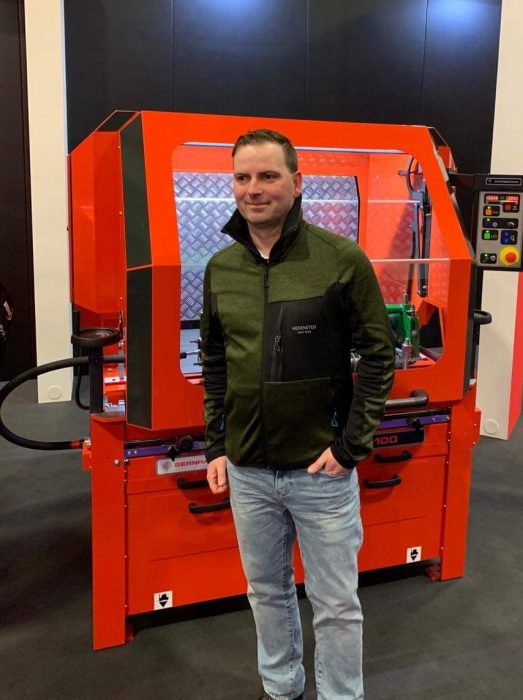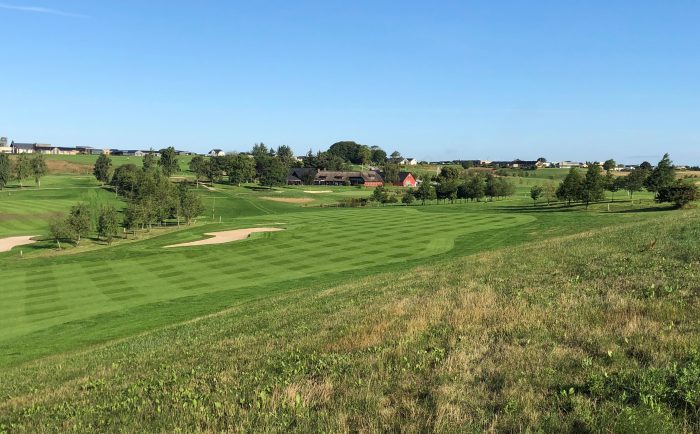Company profile: Bernhard and Company
A Danish golf club that invested in two grinders in 2017 has seen turf definition and the playing surface improve, and the club’s mechanic is now even helping other clubs in the area with their machinery maintenance as a result.
Hedensted Golf Klub is a 15-year-old golf club located in the Danish countryside, just east of Jutland. With 27 holes spread over 100 hectares and a team of five greenkeepers, it’s full of unique natural experiences.
Timm Hansen was educated as a blacksmith but since then he trained as a greenkeeper and for the past five years has worked as a mechanic at Hedensted. In addition, and when time allows, Timm is an enthusiastic volunteer at some of Europe’s top golf tournaments. He was one of the mechanics team during the 2018 Ryder Cup at Le Golf National, France and will this year be lending his support at the inaugural Scandinavian Mixed tournament at Sweden’s number one ranked course – Bro Hof Slott, in June, if it isn’t cancelled due to coronavirus.

Hedensted Golf Klub received its Bernhard grinders in the spring of 2017, a set of Express Dual 3000MC and an Anglemaster 3000MC machines and the club has not looked back since.
When it comes to turf maintenance, surgically-sharp mowers slice through grass blades, severing them cleanly and with minimal damage. Because the grass left in the mower’s wake is the same height and uniform in appearance, overall turf definition is improved and the playing surface smoother, healthier and more consistent.
The grinding process is crucial to maintaining the sharpest blades and, therefore, optimal turf conditions. To help you understand how it works, let’s look at the two components of the cutting unit: the bedknife and the cylinder.
The bedknife is the most important part of any cutting unit. Although it looks simple, it is actually a very complex piece of steel. The bedknife gathers the grass and holds it in position until the cylinder blade comes around to cut it.

Often overlooked are reasons one should also spin grind the cylinder. Yes, it is to make each blade sharp, but it is also to ensure the cylinder is even. There is no point in sharpening all the blades if only every third one cuts because they are not of equal height.
Naturally, a cylinder that is maintained regularly is going to be easier and quicker to grind than one sharpened only once a year. Sharpening of the bedknife and cylinder is integral to maximising their effectiveness and, in turn, turf conditioning.
A dull cutting unit (bedknife and cylinder) will tear at grass, leaving it uneven. These ripped and ragged blades bleed and lose plant moisture and nutrients. The open tips also leave them more vulnerable to disease from fungal spores such as fusarium and other leaf-spot afflictions. Repairing and regenerating the plants then requires a greater demand for chemicals, driving up costs and impacting budgets.
We caught up with Timm to ask how Bernhard’s grinders have helped improve the course’s playability and how they gained their return on investment almost instantly.
During the high season, Timm and his team grind their own greens’ mowers about every four weeks with tees and approach mowers every two months. What’s more special is that Timm and his team not only grind their own units, they also grind about 150 cutting units from other golf clubs within the local area during the winter period.
It’s great to see Timm’s team go above and beyond when assisting other local golf clubs – giving Hedensted back their return on investment in such a short period of time.
Timm explains: “We use Bernhard grinders because we think it is an easy machine to work with. Easy and fast set-up for the many different types of cutting units we grind throughout the year. Especially during the winter season when we are grinding for other clubs, it is nice that the set-up can be done quickly”.
Timm and his team do a great job in sharing best practice with smaller local golf clubs, which may have never used a grinder before and he hones in on the message very close to Bernhard Company’s ethos on turf health.
He says: “It clearly is a good investment for us. Before we got our own grinders, we only got to grind all our mowers once a year, including greens’ mowers in connection with winter preparation.
“But now we are able to sharpen our mowers as often as we need to and whenever necessary, we have seen substantially improved playing surfaces, especially on our greens. Both in terms of the speed and consistency of the ball-roll, but also agronomically with a noticeable reduction in disease outbreak. Furthermore, I see a far less wear and tear on our mowers”.
So top-line benefits are realised with improved turf appearance and better playability. The resulting elevation in customer satisfaction will further enhance revenues, making management and end users alike extremely happy.
A further consideration is the preference by many of today’s turf managers to implement a more frequent programme of light top-dressing of greens. This practice is driven by necessity as modern turfgrasses, while producing better than ever putting surfaces, require higher maintenance.
The upside may be that golfers can play on faster, more consistent greens; the downside is the increased workload for mechanics in keeping cutting units in tip-top condition – all through the season. The only solution in this scenario is to provide mechanics like Timm Hansen with a sharpening system to deal with and easily manage this intensity of cutting unit maintenance.
Agronomically speaking, a reduction in the applications of water, fertiliser and fungicide can be achieved due to turfgrass remaining more robust and healthier as a result of this regular, cleaner, surgical cut. Not only is the use of these important but expensive consumables decreased, but so too are the costs associated with both the handling and the efficient application of these materials.
Going a step further, one can translate fuel reduction into increased mower life, reduced engine wear, fewer replacement parts – and it soon becomes clear that the benefits are very attractive to your facility’s bottom line. Another advantage? Less fuel use means a smaller carbon footprint.
Everybody knows a sharp blade makes a cleaner cut but not everyone realises the financial benefits derived from reduced expenditures on fertiliser, fungicide, chemicals and fuel (for mowing equipment), as well as increased revenues due in part to greater end user satisfaction with the turf. And isn’t better playability not what matters to members?
Web: www.bernhard.co.uk















Let me tell You a sad story ! There are no comments yet, but You can be first one to comment this article.
Write a comment